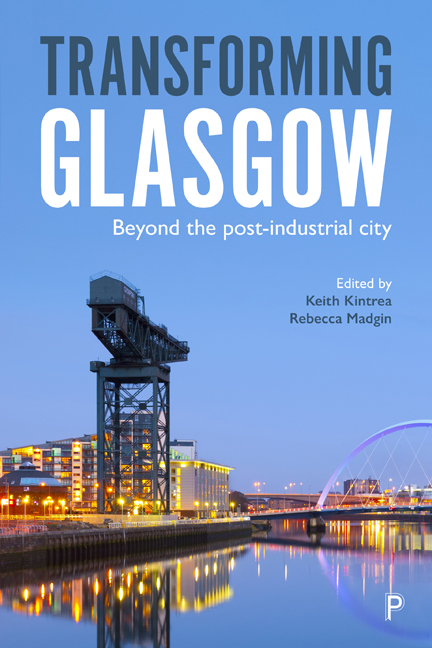Book contents
- Frontmatter
- Contents
- List of Maps, Tables, Figures and Boxes
- Notes on Contributors
- Acknowledgements
- Foreword
- Map
- Introduction: Transforming Post-Industrial Glasgow – Moving Beyond the Epic and the Toxic
- PART I
- PART II
- PART III
- Conclusion: Beyond the Post-Industrial – Narratives of Time and Place
- Index
Introduction: Transforming Post-Industrial Glasgow – Moving Beyond the Epic and the Toxic
Published online by Cambridge University Press: 25 March 2021
- Frontmatter
- Contents
- List of Maps, Tables, Figures and Boxes
- Notes on Contributors
- Acknowledgements
- Foreword
- Map
- Introduction: Transforming Post-Industrial Glasgow – Moving Beyond the Epic and the Toxic
- PART I
- PART II
- PART III
- Conclusion: Beyond the Post-Industrial – Narratives of Time and Place
- Index
Summary
Artistic, brash, chic, dynamic, exuberant – it's difficult to describe Glasgow of the 21st century. Think Manhattan with a Scottish accent, brimming with fine architecture and the best fashion shopping and restaurants outside London. Stunning, state of the art exhibition, conference, concert and science centres now dominate the River Clyde. Glasgow does not follow fashion, she creates her own. (Devlin, 2010)
The uncertain reinvention of a city
The post-industrial transformation of the city of Glasgow is the subject of this book. If a conventional narrative, like Devlin (2010), is to be believed, then the city has gone from a powerful industrial city in the 19th century to a globally competitive city during the 21st century, via a bruising period of deindustrialisation and depopulation. Journalists and guidebook writers praise the city's reinvention.
Forty years ago it was not like that. Writing the conclusion to his history of Glasgow, David Daiches (1977) could only reflect upon the squalor of the city, its violence and its destructive ‘comprehensive redevelopment’. In doing so, he replayed the idea of Glasgow as the UK's most impoverished and dangerous city, but he was at a loss to know where Glasgow was going next, characterising it as poised between a demolished past and an uncertain future (Daiches, 1977). Within a few years, an answer was emerging. Michael Keating's The City that Refused to Die (1988) was a landmark in the transition to a different Glasgow. It documents a range of public policy experiments that established Glasgow as a pioneer of post-industrial regeneration. These included the nascent shift from social policy as welfare to social policy aligned with economic development, and the rise of public– private partnerships in the redevelopment of the built environment. Keating also examined the ‘Glasgow's Miles Better’ campaign, an early example of ‘place marketing’, and the appearance of ‘event-based regeneration’, as Glasgow became host to the UK Garden Festival on the derelict riverside. With these policy shifts also came important physical symbols of Glasgow's new status, all leveraged with public money. These included the Merchant City ‘cultural quarter’, the Scottish Exhibition and Conference Centre (SECC) built on land reclaimed from a disused shipping dock and the opening of the Burrell Collection, a museum whose architecture won awards.
- Type
- Chapter
- Information
- Transforming GlasgowBeyond the Post-Industrial City, pp. 1 - 18Publisher: Bristol University PressPrint publication year: 2019



